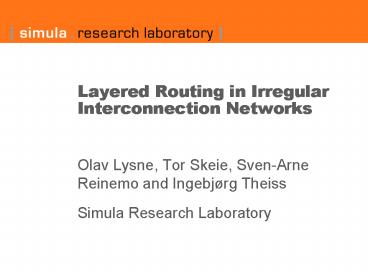Layered Routing in Irregular Interconnection Networks - PowerPoint PPT Presentation
1 / 15
Title:
Layered Routing in Irregular Interconnection Networks
Description:
Olav Lysne and Tor Skeie, Load balancing of irregular system area ... Tor Skeie, Ingebj rg Theiss and Olav Lysne, Evaluation of Minimal Deterministic ... – PowerPoint PPT presentation
Number of Views:28
Avg rating:3.0/5.0
Title: Layered Routing in Irregular Interconnection Networks
1
Layered Routing in Irregular Interconnection
Networks
- Olav Lysne, Tor Skeie, Sven-Arne Reinemo and
Ingebjørg Theiss - Simula Research Laboratory
2
What is an interconnection network?
3
What is an interconnection network
- High speed.
- Extremely low latency.
- Short distance few tens of meters.
- Safe communication the network will never drop
information. - Used within computers, within switches and within
routers.
4
Interconnection networks in Norway
- Dolphin Interconnect Solutions
- Since approx 1990.
- Ships interconnects based on the SCI standard
- From the ashes of Norsk Data
- Scali supercomputers
- From Kongsberg Information Control
- Ships clusters and support software for
supercomputers. - Cooperates tightly with Dolphin
- SUN Microsystems
- Bought staff and licensed technology from Dolphin
- Development center at Skullerud
- Simula Research Laboratory
- Working on these issues from the start
- The second most productive academic research
group in Europe on Interconnection Networks.
5
This work is
- Olav Lysne, Tor Skeie, Sven-Arne Reinemo and
Ingebjørg Theiss, Layered Routing in Irregular
Networks, Submitted to IEEE Transactions on
Parallel and Distributed Systems. - Referee-comments have been received and revision
is in progress. - A compilation of four published papers
- Olav Lysne and Tor Skeie, Load balancing of
irregular system area networksthrough multiple
roots, Proceedings of the International
Conference on Communication in Computing, CIC
2001, CSREA Press, pages 165 -171 - Tor Skeie, Ingebjørg Theiss and Olav Lysne,
Evaluation of Minimal Deterministic Routing in
Irregular Networks, Proceedings of the SSGRR
International Conference on Infrastructure for
e-Business, e-education, e-Science, and
e-Medicine (SSGRR) 2002 - Tor Skeie, Olav Lysne and Ingebjørg Theiss,
Layered Shortest Path (LASH) Routing in Irregular
System Area Networks, Proceedings of
Communication Architecture for Clusters (CAC02),
IEEE Computer society 2002. - Ingebjørg Theiss, Tor Skeie and Olav Lysne,
Minimal Routing in Irregular Networks,
Proceedings of the International Conference on
Communications in Computing (CIC) 2002, IEEE
Computer Society
6
Link level flow control
- Challenges
- Irregularity introduced by topology-agnostic
technologies, and System Area Network COTS. - Deadlock is an issue
- Shortest path routing generally hard in irregular
networks.
C
D
A
B
- Link level flow control
- Mainly used in interconnects and System area
networks (Myrinet, Servernet, AutoNet, 3GIO, AS,
InfiniBand)
7
Network Layers
- Physical channels are divided into a number (N)
of virtual channels - Infiniband has up to 16, PCI-AS has up to
16,interconnect in BlueGene/L has 4, - These channels have mainly been provided for
other purposes in most technologies - Assuming N virtual channels per physical, view
the network as N virtual networks, that are
logically disjoint. - Each of these networks are in the following
called a layer.
8
Main idea
- Assign each source destination pair to one layer,
such that - Each individual layer is deadlock free.
- Each individual layer need not be fully
connected, but the sum of all layers should be. - Through this we obtain routing flexibility
previously not inherent in deadlock prone
technologies. - This flexibility is in the paper used to obtain
higher throughput in the network
9
Two new classes of routing strategies methods
- Load-balancing - MROOTS
- One fully connected routing function in each
layer (Up\Down) - Known hot spots (Up\Down root) are distributed
as far from each other as possible. - Shortest path LAyered SHortest Path - LASH
- Each layer has a subset of the source destination
pairs, for which the deadlock problem does not
appear - No layer is fully connected
- The union of all layers is fully connected.
10
The method has been evaluated for three classes
of networks
- Deterministically routed networks
- All source destination pairs have but one
possible path - InfiniBand, Myrinet, most variants of Ethernet
- Source adaptive networks
- Multiple paths possible between sources and
destinations, but the path for each
packet/connection is decided a priori by the
source (source routing) - Advanced Switching
- Switch-adaptive networks
- Multiple paths possible between sources and
destinations, and the path decisions are taken on
the fly by the switches. - BlueGene\L
11
Evaluated routing methods
12
Results deterministic routing
13
Results Source Adaptive Routing
14
Results Switch Adaptive Routing
15
Conclusions
- We have developed a new class of deadlock free
routing methods - Outperforms all prior art routing-functions in
the deterministic as well as the source-adaptive
case - In the switch-adaptive case, we are not better
than existing methods. - With the enhancement we give for deterministic
routing, source adaptivity is no longer suited
for performance enhancement - Source adaptivity is, however, still useful for
fault tolerance.































